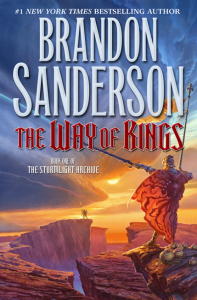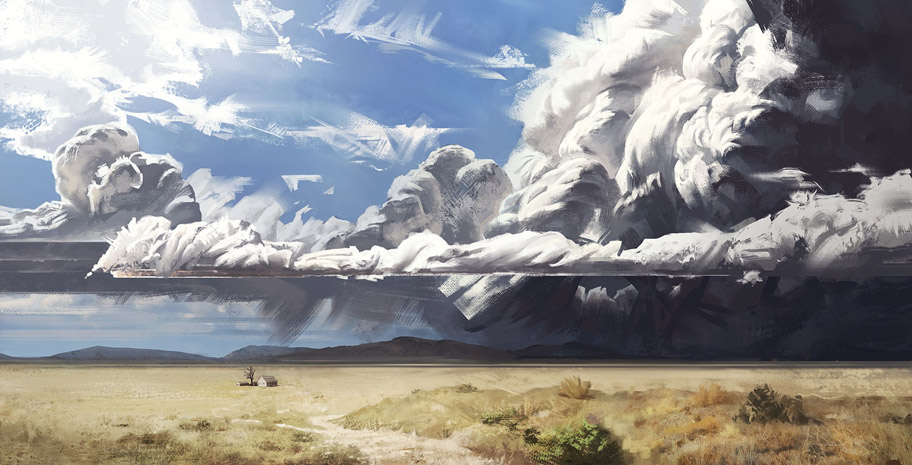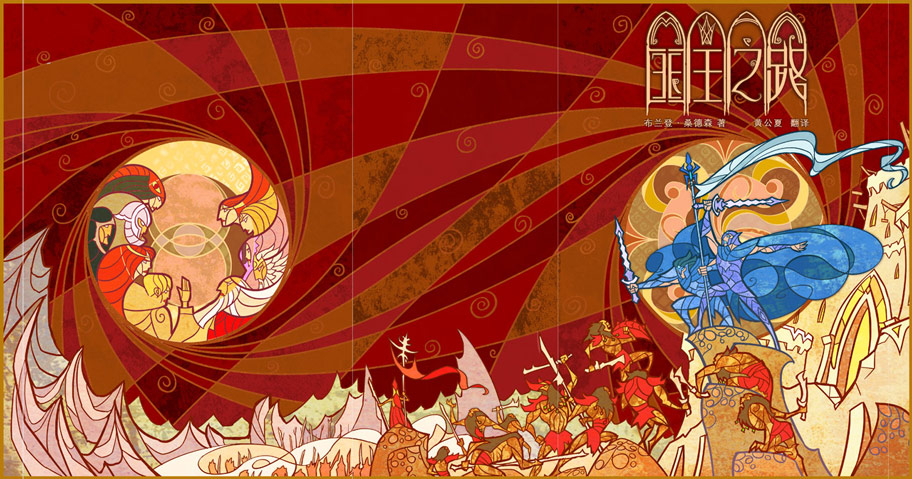How Many Words Is The Way Of Kings

Just one look at the cover of Brandon Sanderson's The Fashion of Kings tells y'all everything you need to know about it. If yous're a fantasy virgin, a passerby in the grocery store, you tin can tell that it's about knights and vivid fantastical set pieces. If you're a long entrenched fantasy reader, y'all tin run into that, for all of publisher Tor Books' will to make information technology so, the first book of Brandon Sanderon'southward The Stormlight Archives is the "next big fantasy, " the heir apparent to Robert Jordan'south legendary and flawed opus, the Bike of Time.
The Style of Kings is big. Thunderously huge. Sanderson might be best known for his work completing the late Robert Jordan's series, merely before that he was known to fantasy fans equally one of the more exciting upcoming epic fantasists. His most popular work upwards to that point was the Mistborn trilogy, a self-contained serial that, while applaudable for Sanderson's eagerness to develop fascinating magic systems, suffered from poor pacing and bloat in both the second and tertiary volumes. The longest of those volumes was two-thirds the length of The Style of Kings, the shortest about half.
Virtually writers are expected to write an epic fantasy in less than 200,000 words, The Way of Kings flirts with 400,000.
Since then, Sanderson's star has risen to heights reached past few other working fantasy authors, and every bit a result the editorial department at Tor has slackened their reins, hoping to nurture the novelist as he attempts to fill the enormous hole left past Jordan's passing. Even in the early pages The Manner of Kings, while Sanderson is busy introducing readers to fallen gods, it's easy to recognize his excitement at being given the reins to write an ballsy fantasy in the vein of Jordan, et al. Most writers are expected to write an epic fantasy in less than 200,000 words, yet The Way of Kings flirts with 400,000. Though this immense privilege and freedom for Sanderson's ambitions hurts the novel, it besides allows for a refreshing boldness and scope that the genre has been missing since the completion of the Cycle of Fourth dimension and Steven Erikson's Malazan Book of the Fallen.

'Before the Tempest' by Nickolas Russell
I establish myself eagerly looking forward to every opportunity I had to fissure open up its many pages, to immerse myself in Roshar.
It's difficult to debate that any novel requires 400,000 words to tell its story. It's an fifty-fifty tougher road to wait a serial to need ten such volumes to accomplish its conclusion. On the surface, The Way of Kings should be enough in-and-of-itself to solidify any chance of anyone arguing successfully for behemoth-sized novels: it'due south slow, plodding, over-complicated, and, even at the end of it'southward final page, feels more like a prologue to a larger story than 1 of the longest published novels of the concluding decade. In that location's a lot wrong with The Manner of Kings, by all means, it'due south a slog of a novel, only despite all of this, I establish myself eagerly looking forwards to every opportunity I had to crack open its many pages, to immerse myself in Roshar.
Why is that?
There's a certain piece of every reviewer'southward mind that likes to find and cast a cold drapery over fannish excitement, similar an objective peanut gallery whose purpose isn't to amuse with clever jokes, merely to advisedly cutting into the author's craft and lay it out bare—the novel's triumphs all the more sweet and pronounced because its failures are exposed for all to see. And then that critic rears its head throughout most of this review. However, over the pitch of its screaming voice, also rises the tempestuous whispers of an unabashed, shameless fan of big, fat, hopelessly labyrinthine fantasy. That voice that has been around in this reviewer'south caput since first picking upwards J.R.R. Tolkien and falling into the wonderful, limitless globe of fantasy.
And if The Way of Kings lacks annihilation, it's a respect for limitations.

The Way of Kings (Chinese Edition) by Jian Guo
It's difficult to read The Style of Kings and not be washed over by the beloved that the author has imbued in his work.
Sanderson is then earnest, so effusively enamoured with his fictional creations, that information technology'south difficult to read The Manner of Kings and not be done over by the love that the author has imbued in his work. It'southward a love of his own cosmos, simply likewise of the epic fantasy'southward lauded history: the enormous scale of Robert Jordan; the worldbuilding and ethnic diversity of Ursula K. Le Guin; the ambivalent armies of Terry Brooks; the otherworldliness and humour of Jack Vance. The Style of Kings is an homage to '80s and '90s fantasy, and, for anyone who grew up reading the peachy authors of those eras, there'southward an almost irresistible desire to forget the novel'south flaws and just enjoy the ride.
The Way of Kings has that same obsessive, addictive quality that makes all of Sanderson's other works and then effective. Information technology's not and so much near what it offers readers, only almost what it tin can offering readers. Promises abound, hints of world-changing events, and mind-angle graphic symbol developments to come. Nobody does foreshadowing in ballsy fantasy as well every bit Brandon Sanderson, and, if his previous work is any indication, every small detail in this early book will have a ripple-similar effect on the volumes that follow. Every affiliate is full of questions, full of the type of plot developments and world building that fills chatter effectually water coolers or playgrounds.
"Oh my god, could you believe when Kaladin…"
"Man, I but tin can't expect until Dalinar finally gets his revenge on…"
"Ten heartbeats? That character? Whaaaaat?"
It's immensely piece of cake to sink into Roshar, to experience the ho-hum momentum of a diverse globe on the border of utter anarchy. As Shallan feels slow goosebumps spread on her arms at a terrifying revelation, and then do y'all. As Dalniar ponders the sociological, political, and ethical impacts on the tiresome genocide of his enemies, y'all feel his frustration flushing your cheeks. Equally Kaladin struggles against his own inner voice, you scream at him to button through, to live.
It's so piece of cake to requite everything to the novel, to concede everything as a reader that epic fantasy asks for. To get invested in the fate of this new earth.
But, then, with a sigh, the reviewer sits downwards to write a review, and that little critical voice in his head is just a lilliputian louder, a fiddling more than eloquent, than the fanboy.
While everyone agrees that Sanderson is among the best conceptual epic fantasy writers, crafting some of the genre's near intricate and methodically developed magic systems, opinion on his characterization is split. As a reader who remembers Vin, Kelsier, Sazed, and the other characters from his Mistborn trilogy fondly, I was initially disappointed to find myself somewhat less attached to the three main protagonists of The Style of Kings: Kaladin, Dalinar, and Shallan.
Pinpointing the exact source of this detachment is difficult, but a major contributing factor is that the novel, for all of its pages, equally mentioned above, feels more like a prologue to a larger serial, an attempt by Sanderson to innovate readers to his world and his characters, without introducing them to the serial' overarching plotline until the very concluding pages. Fifty-fifty by the 1,000 folio mark, it is difficult to recognize how each of the protagonists fits together into the large, puzzle-like plot of the serial. Individually, each graphic symbol struggles with intensely personal challenges, but Epic Fantasy is almost the bigger picture, and in The Manner of Kings it can sometimes be difficult to see the forest for the trees.
Individually, each of the 3 protagonists is likeable in their own way, and their storylines, each of which crossover only slightly, are intriguing enough that you don't mind spending so long at their side (notably, each of the three protagonist storylines, if the others were removed, would nonetheless be longer than many other novels.) Sanderson's not subtle in the manner he establishes the main characteristics that define Dalinar (patriotism), Kaladin (perseverance), and Shallan (naivety), or, the trait that ties them all together: obsession. By casting the three characters in such different life situations, with vastly different backgrounds, and levels of life experience and globe-weariness, Sanderson does an effective, if surface-level, job of exposing readers to the thought that the truth of the earth globe is changes based on the perceptions of those whose eyes you're looking through.
Central to all plot lines in The Way of Kings is the social and civic relationship between the "darkeyes" (slaves and poor working course) and the "lighteyes" (privileged nobles) of Alethkar. Presented as a fairly obvious analogue to slavery in post-Revolutionary War America, this exploration of institutionalized racism is present on nearly every folio in the novel, used as a machinery for separating the "adept guys" from the "bad guys." Dalinar is adept, for example, because he treats the darkeyes with slightly more respect than the other lighteyes, despite existence viciously racist towards the Parshendi that he fights. Shallan, in all her naive charm, recognizes and acknowledges these issues very rarely, proving her innocence. Kaladin'southward very being and obsessions revolve around a violent by feel with a lighteyed noble, and results in drowning anger towards the noble course.
Add to this, Kaladin is not only a darkeyes, he's a slave and sold into the Alethi army equally a "bridgeman," a team of humans whose sole purpose in the regular army is to run enormous, army-bearing bridges ahead of the army's main forces to enable them to cross the enormous chasms that split the Shattered Plains, a contested zone that has seen war between the Alethi and the mysterious Parshendi. Kaladin is cast in a role that would not be out-of-identify in the relentlessly grim work of authors like Joe Abercrombie or Marker Lawrence, but Sanderson'due south slightly juvenile writing style is a somewhat uncomfortable partner for Kaladin's hopeless situation.
However, despite their direct impact all of the novel'due south diverse storylines, Sanderson never graduates past surface-level examinations of these themes. So, while they do a prissy job of framing the narrative, and exposing readers to the high level concept that Alethkar is dominated by institutionalized racism, The Way of Kings never achieves the intellectual depth of Ursula Chiliad. Le Guin, the satirical elegance of Terry Pratchett, or the raw emotion of Nnedi Okorafor. Those are lofty names to place Sanderson abreast, simply Sanderson'due south taken a large bite of a very serious matter, and if you join a hot domestic dog eating competition, you're going to be compared to Kobayashi.

Buy The Style of Kings by Brandon Sanderson: Book/eBook
The Mode of Kings is very clearly the first chapter of a much larger tale.
One of The Way of Kings' greatest oddities, something I'k still contemplating midway through the second novel, is that, despite being 1,200 pages long, there are just four existent distinct set up pieces in the novel: the Palanaeum (a large library) where Jasnah and Shallan study, the Alethi war camps on the Shattered Plains, the bridgeman camps on the Shattered Plains, and the battlefields of the Shattered Plains. Epic fantasy oft finds strength in its ability to offering enormous variety and opportunity to innovate readers to a big number of interesting locations and people. Throughout The Way of Kings, Sanderson hints at many other lands, and briefly exposes readers to these wonderful places in the novel'southward various interludes, where they succeed in illustrate that Alethi civilization is only one pocket-sized corner of a diverse and thriving globe, but each of the main storylines has a radius of only a few dozen kilometers. Whether this is a flaw or an interesting twist on convention is subjective, but this illustrates some unusual restraint for a novel that otherwise embraces self-indulgence.
The Way of Kings is very clearly the first chapter of a much larger tale. Despite its flaws, The Fashion of Kings proves that Sanderson has the ambition to fill the hole left after the conclusion of Robert Jordan's Wheel of Fourth dimension, and continue establish himself as ane of the almost successful and prolific young fantasy novelists. Like many opening volumes before it, The Way of Kings convinces readers that the best is yet to come.
Source: https://aidanmoher.com/blog/review/2014/04/the-way-of-kings-is-paved-with-peril-and-many-pages/
Posted by: cherrydented77.blogspot.com

0 Response to "How Many Words Is The Way Of Kings"
Post a Comment